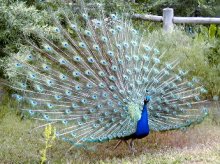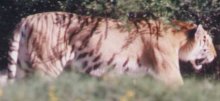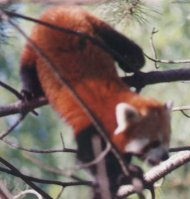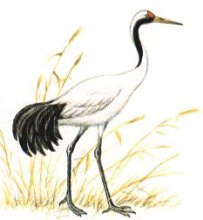 |
Snow
leopard ~ Panthera uncia (unica)
542,000 to 111,000 on Google
The snow leopard (Panthera uncia or Uncia uncia) is a
moderately large cat native
to the mountain ranges of South Asia and Central Asia.
Snow leopards occupy alpine and subalpine areas generally
3,350 and 6,700 metres above sea level in Central Asia.
Snow leopards are smaller than the other big cats but, like
them, exhibit a range
of sizes, generally weighing between 27 and 55 kg (60 and
120 lb), with an
occasional large male reaching 75 kg and small female of under
25 kg.
Body length ranges from 75 to 130 centimetres , with the tail
adding a further 80
to 100 cm to that length. These cats stand about 60 cm at
the shoulder.
|
GIANT PANDA ~
Ailuropoda melanoleuca
The giant panda, or panda, Ailuropoda melanoleuca,
literally meaning
"black and white cat-foot" is a bear native to central-western
and south
western China. It is easily recognized by its large, distinctive
black patches
around the eyes, over the ears, and across its round body.
Though it belongs to the order Carnivora, the panda's
diet is 99% bamboo.
Pandas in the wild will occasionally eat other grasses, wild
tubers, or even
meat in the form of birds, rodents or carrion. In captivity
they may receive
honey, eggs, fish, yams, shrub leaves, oranges, or bananas
along with specially prepared feed.
The giant panda lives in a few mountain ranges in central
China, mainly in
Sichuan province, but also in the Shaanxi and Gansu provinces.
Due to
farming, deforestation and other development, the panda has
been driven
out of the lowland areas where it once lived.
|
 Only
1.000 left in wild,
Only
1.000 left in wild,
One of world's rarest animals
|
|
|
RED PANDA ~ Ailurus fulgens
The red panda, Ailurus fulgens, or
shining-cat, is a small arboreal mammal
native to the eastern Himalayas and southwestern China. It
is the only extant species of the genus Ailurus. Slightly
larger than a domestic cat, it has
reddish-brown fur, a long, shaggy tail, and a waddling gait
due to its shorter
front legs. It feeds mainly on bamboo, but is omnivorous and
may also eat eggs,
birds, insects, and small mammals. It is a solitary animal,
mainly active from
dusk to dawn, and is largely sedentary during the day.
The head and body length of red pandas averages 56 to 63 cm,
and their tails
about 37 to 47 cm . Males weigh 3.7 to 6.2 kg and females
4.2 to 6.0 kg .
They have long, soft reddish-brown fur on the upper parts,
blackish fur on
the lower parts, and a light face with tear markings and robust
cranial-dental
features.
|
ARABIAN ORYX ~ Oryx leucoryx
The Arabian Oryx, Oryx leucoryx,or White Oryx is a
medium sized antelope with a distinct shoulder hump, long
straight horns, and a tufted tail. It is a bovid, and the
smallest member
of Oryx genus,
native to desert and steppe areas of the Arabian peninsula.
The Arabian Oryx was extinct in the wild by the early 1970s,
but was saved in zoos and
private preserves and reintroduced into the wild starting
in 1980.
Arabian Oryx stand about 1 meter high at the shoulder and
weigh around 70 kilograms.
Their coats are an almost luminous white, their undersides
and legs are brown, and there are
black stripes where the head meets the neck, on the forehead,
on the nose and going from
the horn down through the eye to the mouth. Both sexes have
long straight or slightly curved
ringed horns which are 50 to 75 centimeters long.
|
 |

|
GIANT HONEY BEE in Assam
~ Apis dorsata
Apis dorsata, the giant honey bee, is a honey bee of southern
and southeastern Asia mainly in forested areas like the Terai
of Nepal. The subspecies with the largest individuals is the
Himalayan cliff honey bee - Apis dorsata laboriosa
- but typical
Apis dorsata workers from other subspecies are around
17–20 millimetres long.
The bees have given scientists problems in
many ways. One is their fantastic ability to navigate. When
winter is entering the area it brings an end to the blossom-season
in Himalaya. Then, the bees travels several hundred kilometers
south, i.e. to the wetland areas around the mouth of river
Bramaputra.
But the largest mystery is this: The workers
amongst the bees live for only three months, and the bees
returning next year are from their 2nd or 3rd generation,
and they have never been 'aboad' before! Still they return,
not onlyh to the same tree, but to the same branch where the
original bees came from..
|

Peafown are the name of three
species of birds in Asia and Africa.
Indian Peafowl, Pavo cristatus
Green Peafowl, Pavo muticus
Congo Peafowl, Afropavo congolensis |
Peafowl ~ Pavo cristatus
The Indian Peafowl or Blue Peafowl,
Pavo cristatus is a large and brightly coloured
bird of the pheasant family native to South Asia, but introduced
and semi-feral in
many other parts of the world. The peacock (male) is predominantly
blue with a
fan-like crest of spatula-tipped wire-like feathers and is
best known for the long
train made up of elongated upper-tail covert feathers which
bear colourful eyespots.
These stiff and elongated feathers are raised into a fan and
quivered in a display
during courtship. The female lacks the train, has a greenish
lower neck and has a
duller brown plumage. They are found mainly on the ground
in open forest or
cultivation where they forage for berries, grains but will
also prey on snakes, lizards,
and small rodents.
Their loud calls make them easy to detect, and in forest areas,
often indicate the
presence of a predator such as a tiger.
They forage on the ground, moving in small
groups and will usually try to escape on foot through undergrowth
and avoid flying.
They will fly up into tall trees to roost, however. It is
a bird that is celebrated in
Indian and even Greek mythology and is national bird of India.
|
Eclectus Parrot,
Eclectus roratus polychloros
The Eclectus Parrot, Eclectus roratus, is a parrot
native to the Solomon Islands,
Sumba, New Guinea and nearby islands, northeastern Australia
and the Maluku
Islands (Moluccas).
It is unusual in the parrot family for its extreme sexual
dimorphism of the colours
of the plumage; the male having a mostly bright emerald
green plumage and the
female a mostly bright red and purple/blue plumage. Joseph
Forshaw, in his book
Parrots of the World, noted that the first European ornithologists
to see Eclectus
Parrots thought they were of two distinct species. Large
populations of this parrot
remain, and they are sometimes considered pests for eating
fruit off trees. Some
populations restricted to relatively small islands are comparably
rare. Their bright
feathers are also used by native tribes people in New Guinea
as decorations.
How they got into this page about Asian wildlife I don't
know any longer.
|

©
Utah's Hogle Zoo
|

©
Utah's Hogle Zoo
The Chinese alligator,
Alligator sinensis, is one of two
known living species of Alligator,
a genus in the family Alligatoridae.
The Chinese alligator is native
only to China.
|
Chinese Alligator,
Alligator sinensis
While it originally ranged through much of China, this species'
wild habitat has
been reduced to little more than a few ponds containing 100
to 200 individuals
along the lower Yangtze River in the provinces of Jiangsu,
Zhejiang, and Anhui.
Its population reduction has been mostly due to conversion
of its habitat to
agricultural use. A majority of their usual wetland habitats
have been turned
into rice paddies. Poisoning of rats, which the alligators
then eat, has also been
blamed for their decline. In the past decade, very few wild
nests have been
found, and even fewer produced viable offspring.
While its appearance is very similar to the only other living
member of the genus,
the American alligator, there are a few differences. One obvious
difference is that
the Chinese alligator is quite small. Usually only attaining
a length of 1.5 m,
|
|
Red-crowned Crane - Grus japonensis
(japonicus)
The Red-crowned Crane, Grus japonensis, also called the Japanese
Crane or
Manchurian Crane (Chinese: Hanyu Pinyin: Danding Hè;
Japanese: tancho,
is a large east Asian crane and among the rarest cranes in
the world. In some
parts of its range, it is known as a symbol of luck, longevity
and fidelity.
Adult Red-crowned Cranes are snow white with black to the
wings (appears
almost like a black tail when standing, but the real tail
feathers are white),
blackish to the head and neck, and a patch of red skin on
the crown.
This patch of skin becomes brighter red when the crane becomes
angry or excited.
This species is among the largest cranes, typically measuring
about 158 cm tall,
136 cm in length (from bill to tail tip) and spanning 242.5
cm across the wings.
Typical body weight can range from 7 to 10 kg , with males
being slightly larger
than females and weight ranging higher just prior to migration.
|
|
More about Cranes,
click here.
|

|
A camel is an even-toed ungulate
within the genus Camelus, bearing distinctive
fatty deposits known as humps on its back. There are two species
of camels:
the dromedary or Arabian camel has a single hump, and the bactrian
has two
humps. Dromedaries are native to the dry desert areas of West
Asia, and
Bactrian camels are native to Central and East Asia. Both species
are
domesticated; they provide milk and meat, and are working animals.
The term camel is derived via Latin and Greek from Hebrew or
Phoenician
gamal, possibly from a verb root meaning 'to bear/carry' (related
to Arabic jamala).
Camel is also used more broadly to describe any of the six camel-like
creatures in the family camelidae: the two true camels, and
the four South
American camelids: the llama, alpaca, guanaco, and vicuña.
The average life expectancy of a camel is 40 to 50 years.
A fully grown adult camel stands 1.85 m at the shoulder and
2.15 at the hump.
The hump rises about 75 cm out of its body. Camels can run at
up to 65 km/h
in short bursts and sustain speeds of up to 40 km/h |
|
White-handed Gibbon Hylobates
lar
The range of the lar gibbon historically extended from southwest
China
to Thailand and Burma down the whole Malay Peninsula in primary
and
secondary tropical rain forests. It is also present in the
northwest portion
of the island of Sumatra.
Lar gibbons are diurnal and arboreal, inhabiting rain forests.
They rarely come to the ground, instead using their long arms
to
brachiate through the trees. With their hooked hands they
can move
swiftly with great momentum, swinging from the branches.
Although they rarely come to the ground naturally, when on
the ground
they walk bipedally with arms raised above the heads for balance.
Their social organization is dominated by monogamous family
pairs,
with one breeding male and one female along with their offspring.
When a juvenile reaches sexual maturity, it is expelled from
the family unit.
|

©
Utah's Hogle Zoo
The lar gibbon, Hylobates lar, also known as the white-handed
gibbon, is a primate in the Hylobatidae or gibbon family.
It is one of the better-known gibbons and is often seen
in zoos.
See
more here
and even more here
|
 5.000-7.500,left
in wild.
5.000-7.500,left
in wild.
They were 100.000 just 100 years ago.
|
Tiger ~ Panthera tigris
The tiger, Panthera tigris is the largest cat species, reaching
a total body
length of up to 3.3 metres and weighing up to 300 kg. Their
most
recognizable feature is a pattern of dark vertical stripes
on reddish-orange
fur with lighter underparts. They have exceptionally stout
teeth, and their
canines are the longest among living felids with a crown height
of as much
as 74.5 mm or even 90 mm.
In zoos, tigers have lived for 20 to 26 years, which also
seems to be their
longevity in the wild. They are territorial and generally
solitary but social animals, often requiring large contiguous
areas of habitat that support their
prey requirements.
|
See more about the tiger - click here
|



















